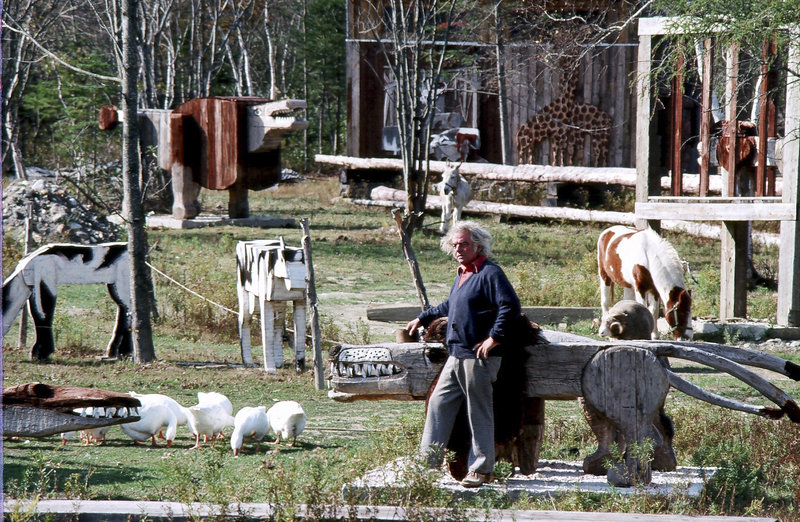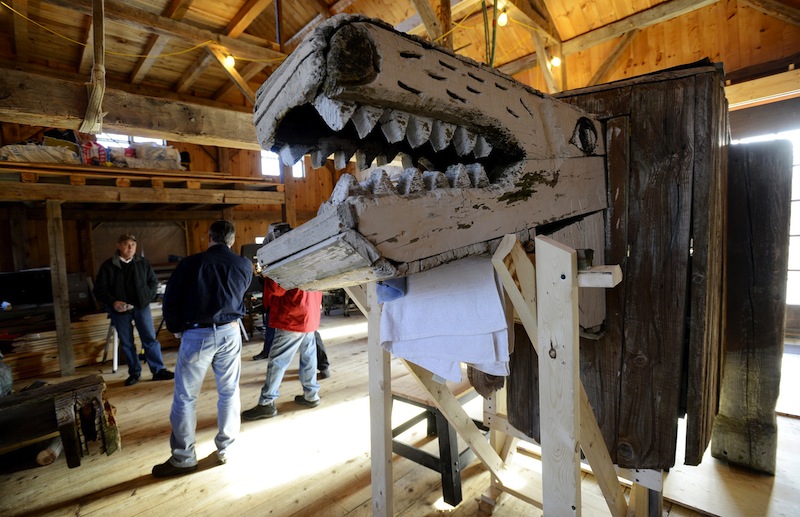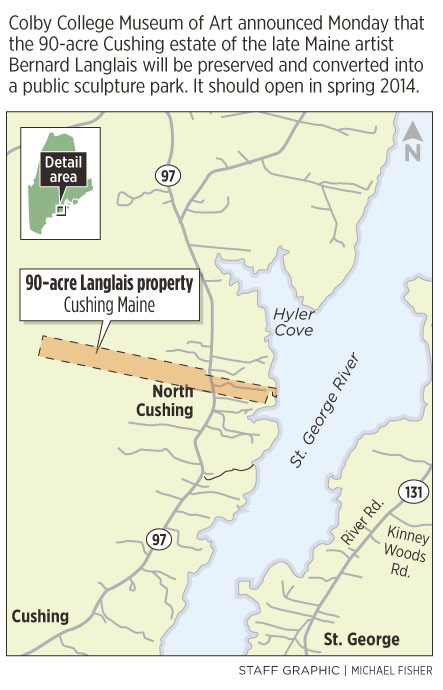The work of the late Maine artist Bernard “Blackie” Langlais will be distributed for free and the place where he made it will be preserved, in an arrangement announced Monday by the Colby College Museum of Art.
A portion of the Langlais estate in Cushing will become a public sculpture park, and many of the 3,000 pieces of art that remain in the estate will be given to nonprofit institutions in Maine and around the country, said Colby’s museum director, Sharon Corwin.
Colby has retained about 200 pieces and plans a major Langlais show in 2014.
Several large wooden sculptures will be left on the property along the St. George River for a sculpture park with a target opening of spring 2014.
“We have arrived at an innovative way to maintain his legacy and open up a site that allows the public to enjoy these sculptures and that will leave this land and this special place that Blackie created for the people of Maine and visitors to the state,” Corwin said.
The agreement involves the Colby museum, which was given the land and a large bequest of artwork by Langlais’ widow, Helen, who died in 2010; the Kohler Foundation of Wisconsin, whose mission includes the preservation of art environments; and the Georges River Land Trust, which will take ownership of the 90-acre estate this year and collaborate with Colby on the sculpture park.
“This is a great opportunity to make that very tangible connection between the artist community that lives in our area and the natural landscape,” said Gail Presley, executive director of the Georges River Land Trust. “We are really excited about doing a project with that as a primary purpose.”
Langlais, who died in 1977, was born in Old Town and is best known for making oversized, whimsical wooden sculptures that dot the landscape at the sprawling estate. His most famous piece may be a 62-foot Abenaki Indian in Skowhegan.
He also made many works on paper, paintings and smaller wood-relief sculptures. Those pieces comprise most of the estate left to Colby.
Langlais studied at the Skowhegan School of Painting and Sculpture, moved to New York and made a name for himself there in the 1950s.
He was among a wave of artists who came to Maine in the 1960s in search of open space and inspiration. He and his wife started living at their property in Cushing in 1966.
Colby acquired the property after Helen Langlais died in 2010. That fall, Colby’s assistant curator Hannah Blunt moved into the Langlais home and began a two-year process of evaluating and archiving individual pieces of art.
Colby kept about 200 of the best pieces, then formed a partnership with the Kohler Foundation to place the remaining works in collections and interpret the property for visitors.
When that work is done, the property will be turned over to the Georges River Land Trust, which will manage the sculpture park.
The Langlais property is on the same road as the Olson House, which is owned by the Farnsworth Art Museum. Andrew Wyeth used the Olson House as the setting for his best-known painting, “Christina’s World.”
The land trust hopes that the proximity of the two properties will create an art trail on the peninsula.
Blunt’s two years on the Langlais property motivated Colby to preserve it as a place for public visitation.
“The whole aura of the place really got inside of me. It’s a magical spot,” Blunt said. “It felt alive, even though he is gone.”
Part of that is because of his sculptures. Langlais built them in his barn, then hauled them out across the property, at times filling it with as many as 100 or so pieces. Over time, many of those sculptures have deteriorated, subject to the scorn of the weather.
Some of those pieces will be removed, conserved and distributed to institutions. Others will be left to “go back to the earth from whence they came,” Corwin said. “The expectation should be that we are creating a site in the name of Blackie and Helen that these sculptures will be a part of. But they do not have an infinite life. We are not saving these works for ever and ever. That would be an unrealistic expectation.”
Some museums that own Langlais pieces are conserving them. For instance, the Ogunquit Museum of American Art has engaged in a project to conserve several large pieces.
The park will include an informational kiosk and a series of trails and paths to lead visitors from one sculpture to the next. It is too soon to say how many sculptures will remain when the park opens.
The house in which Langlais lived is not part of the project, Corwin said.
The Kohler Foundation has begun placing his art in museums, colleges and other public institutions. Because of the volume that remains, Kohler is interested in giving away as much of it as possible. The foundation is soliciting requests, said Kohler’s Executive Director Terri Yoho.
“If there are entities in Maine or beyond that have an interest in taking on some of the pieces of art for their collections, we would entertain a phone call or email,” she said.
Nonprofit organizations with an interest in the work and the ability to care for it should contact the Kohler Foundation through its website, kohlerfoundation.org.
Bob Keyes can be contacted at 791-6457 or at:
bkeyes@pressherald.com
Twitter: pphbkeyes
Send questions/comments to the editors.






Success. Please wait for the page to reload. If the page does not reload within 5 seconds, please refresh the page.
Enter your email and password to access comments.
Hi, to comment on stories you must . This profile is in addition to your subscription and website login.
Already have a commenting profile? .
Invalid username/password.
Please check your email to confirm and complete your registration.
Only subscribers are eligible to post comments. Please subscribe or login first for digital access. Here’s why.
Use the form below to reset your password. When you've submitted your account email, we will send an email with a reset code.